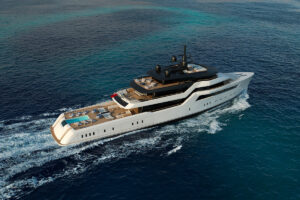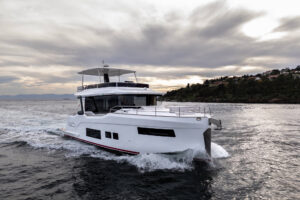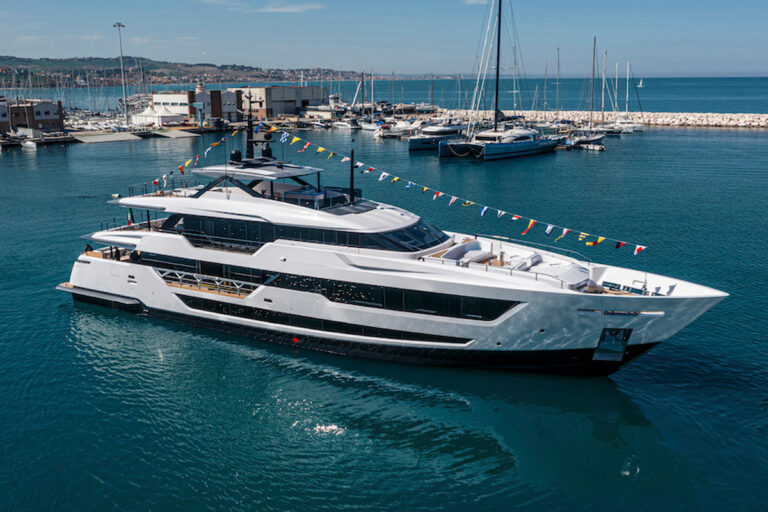Sea Ray is perhaps best known for its pioneering efforts in large express-style designs. Its successful Sundancer brand seems synonymous with this stylish category. Sea Ray, of course, builds other sorts of boats, and if I were to choose another Sea Ray segment that has helped shape the sport, the Sedan Bridge line comes to mind. Recently, I had the opportunity to take the new 420 Sedan Bridge out for a sea trial.
The Sedan Bridge line was created for folks who like convertible styling and performance but do not feel they need to fish seriously. While she has rodholders, her focus is really on providing plush cruising comfort and a platform for fun on the water. The 420 is a worthy addition to the series and a worthy replacement for the successful and very popular 400 Sedan Bridge. She is the smallest Sedan Bridge currently offered; a 480 and 560 are in production.
She is, in my view, the perfect size for a cruising couple or young family. A staircase allows easy passage from the bridge to the cockpit, and the side decks are wide enough for a mate to carry lines and fenders forward. An anchor and electric windlass are included in the standard package, and shore-power connections and fender and line stowage are hidden conveniently in a transom locker.
The cockpit is arranged with optional forward-facing bench seating and an icemaker. There is also room for several deck chairs, creating a great place for soaking in a sunset. I found the helm comfortable, although there is no view of the cockpit due to the extended bridge overhang. This is a worthwhile sacrifice considering her intended service and the useful space gained. The extended bridge is home to a seating area with a table. I recommend the larger optional table that drops to form a sunpad, providing more flexibility.
A rather unique arch encompassing an integrated top formed with welded aluminum framework caps the bridge. This area is enclosed with canvas, and the isinglass curtains can be raised or removed. It is a clever design that is more attractive and less bulky than a conventional fiberglass hardtop design.
The dining area, two steps up, seats three adults. This is the focal point of the cabin, and when seated, one has a 360-degree view of the outside. The galley area, a step down, is outfitted with a cooktop, a microwave and dual-voltage refrigeration. This area also has a full-length pantry and stowage for tableware.
Below, a guest cabin to port has two single berths that convert to a double with filler. This cabin is a bit tight, but it is fine for kids or close friends. The guest/day head is accessible from the passageway and has a separate shower.
Cabin trim and finish include durable faux-wood laminates, molded simulated-granite countertops, metallic details and European-style hardware and fixtures. The result is a rich, upscale interior that benefits also from large saloon windows, which provide plenty of natural lighting. Worthwhile interior options include a central vacuum system and washer/dryer, which is hidden behind the galley stair. Sea Ray also offers an arrangement with a lower helm station in place of the dinette. This option is geared to the European market and Pacific Northwest yachtsmen looking to prolong the boating season.
Having owned a Sea Ray and been on board many for sea trials, it would be easy for me to take the 420’s performance for granted. Not all builders, however, are blessed with a stable of performers as capable and consistent-the 420 is a solid fit. Her 18-degree transom deadrise, more or less the standard throughout the line, is appropriate for her service.
Given throttle, she rose to a plane without excessive trim or smoke and reached full speed in less than 20 seconds, impressive for a boat this size. At speed, her Teleflex hydraulic steering is precise. Water breaks clear from her chine well abaft the stem, and her ride should be bone-dry in more challenging conditions. Sound levels on the bridge and in the saloon are worthy of note. Clearly, Sea Ray‘s patented underwater exhaust system works quietly.
I recorded a top speed of 28.3 knots at 2680 rpm. This is a few turns higher than the recommended 2600 rpm, but when loaded with owner’s gear she should be right on the money. According to Cummins’ data, owners should expect total fuel burn to be a bit shy of 40 gallons per hour at just under 25 knots (2400 rpm). While she is limber dockside, the optional bowthruster is useful and had plenty of power to turn her head in a breeze.
Our test boat was fitted with a Mercury SmartCraft electronic information system that coordinates and displays data from a number of sources. It was also equipped with the Sea Ray Navigator system, which displays navigation information on a 10.4-inch, sunlight-viewable touchscreen LCD. Even with these accessories, the automotive-style dash had plenty of space for a large display unit and full instrumentation.
The 420 is built at Sea Ray‘s Palm Coast, Florida, facility. She began life at Sea Ray‘s engineering center, where designers create new models. Once defined on the computer screen, Sea Ray cuts tooling on a computerized five-axis router. The pieces that result (hulls, superstructures and so on) are near perfect.
The 420’s solid hull laminate is a handlaid blend of fiberglass woven roving, stitched reinforcements and mat. The bulk of the lamination is polyester resin, while vinylester resin is used just beneath the gelcoat to enhance blister resistance. A hatch in the cockpit allows access to the machinery space. Hinged hatches in the cabin permit more complete access to the engines.
For those interested in cruising fun, the 420 has a lot to offer. She is a well-thought-out design with features that make sense. Considering her accommodations, performance and Sea Ray‘s reputation for customer service, she is a very good value.
Contact: Sea Ray Boats Inc., (800) SRBOATS; www.searay.com. For more information, contact: (866) 922-4877; www.yachtingnet.com/yachting/productinfo.









